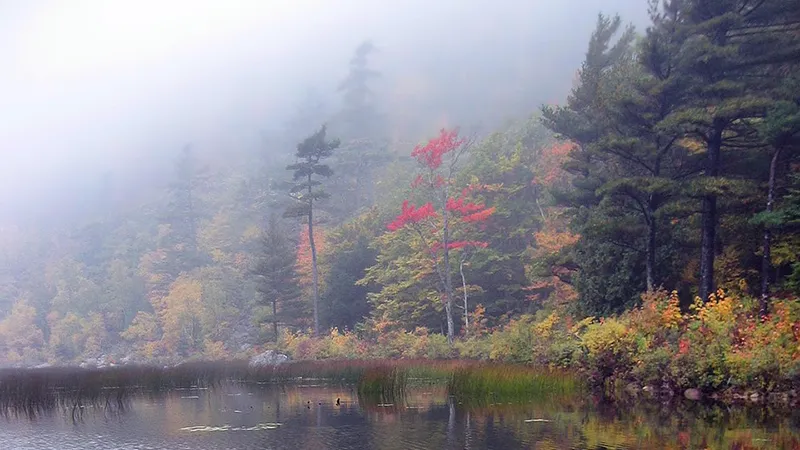Reed Plantation MaineATTRACTIONS & THINGS TO DO
Listed below are the best attractions and things to do near Reed Plantation, Maine.
1. Wytopitlock Veterans Memorial
HONORING LOCAL HEROES
Wytopitlock Veterans Memorial is a tribute to local veterans located in the village of Wytopitlock within Reed Plantation. The memorial offers visitors a chance to pay respects to those who served their country. It serves as an important historical landmark for the community and visitors alike.
2. Mattawamkeag River
SCENIC WATERWAY EXPERIENCE
The Mattawamkeag River flows through Reed Plantation and the village of Wytopitlock. Visitors can enjoy fishing, canoeing, or simply taking in the natural beauty along its banks. The river has historically been important to the region's development and settlement.
3. Central Lot Historical Site
PIONEER SETTLEMENT REMAINS
Central Lot Historical Site features at least three cellar holes with corresponding wells and stone walls from early settlers. The old field remains relatively open and includes several heritage apple trees. This site offers a glimpse into the plantation's past dating back to when John Clifford first settled the area in 1830.
4. Moosehorn National Wildlife Refuge
WILDERNESS AND WILDLIFE
Moosehorn National Wildlife Refuge is a protected area near Reed Plantation offering trails, fishing, hunting, and wildlife observation opportunities. The refuge serves as an important habitat for numerous native animal species and migratory birds. Visitors can enjoy educational programs and scenic hiking throughout its extensive grounds.
5. Popham Beach State Park
PRISTINE COASTAL BEAUTY
Popham Beach State Park is a highly-rated coastal destination featuring expansive sandy beaches and stunning ocean views. The park offers numerous amenities including picnic areas, changing facilities, and recreational opportunities for the whole family. Visitors particularly enjoy the beach during low tide when it becomes dramatically more expansive.
6. Reid State Park
SCENIC COASTAL RETREAT
Reid State Park is a 770-acre scenic coastal park featuring two saltwater beaches and one freshwater beach. The park offers numerous amenities including interpretive displays, picnic tables, changing areas, a children's play area, and restrooms. Despite being somewhat remote, visitors find the park's natural beauty and reasonable admission fees make it well worth the trip.
7. Fort Popham State Historic Site
CIVIL WAR ERA FORTRESS
Fort Popham State Historic Site preserves a semicircular granite fort built in 1862 during the Civil War era. Visitors can explore the fort's architecture and learn about its historical significance through informational displays. The site also offers picturesque views of the Kennebec River as it meets the Atlantic Ocean.
8. Burnt Island Lighthouse
HISTORIC MARITIME BEACON
Burnt Island Lighthouse is a historic lighthouse established in 1821 that continues to guide mariners today. Visitors can tour the restored keeper's house and learn about the life of lighthouse keepers through living history programs. The five-acre island also offers beautiful views of the surrounding harbor and coastal landscape.
9. Ice Age Trail
GLACIAL GEOLOGICAL WONDERS
The Ice Age Trail showcases the profound effects that glaciation had on Maine's Downeast landscape. The trail connects the finest and most accessible geological features sculpted by vast sheets of ice during the last ice age. Visitors can observe carved mountains, fjords, and spectacular sand barrens while learning about this significant period in Earth's history.
10. Downeast Fisheries Trail
MARITIME HERITAGE PATH
The Downeast Fisheries Trail connects historic and active fisheries sites from Penobscot Bay to Cobscook Bay, illustrating the region's rich maritime heritage. The trail highlights how marine resources have sustained the culture and economy of Downeast Maine throughout its history. Visitors can use printed map-brochures to navigate between significant locations that tell the story of the region's relationship with the sea.
11. Sculpture Symposium Tour
PUBLIC ART JOURNEY
The Sculpture Symposium Tour showcases large-scale sculptures created by world-class artists permanently situated throughout downeast Maine communities. Visitors can enjoy public art while taking in Maine's scenic vistas on this self-guided tour. The sculptures were created as part of the Schoodic International Sculpture Symposium, bringing fine art into the natural landscape.
12. Georgetown Historical Society
LOCAL HERITAGE CENTER
The Georgetown Historical Society preserves and showcases the rich history of Georgetown and the surrounding region. Visitors can explore exhibits featuring artifacts, photographs, and documents that tell the story of the area's development over time. The society also hosts educational programs and events that bring local history to life for all ages.
13. Sail Muscongus Day Tours
COASTAL SAILING ADVENTURES
Sail Muscongus Day Tours offers memorable sailing experiences along the picturesque Maine coast. Visitors can enjoy guided excursions that showcase the region's natural beauty, wildlife, and maritime heritage. The highly-rated tours provide opportunities for both relaxation and adventure on the waters of Muscongus Bay.
14. Wytopitlock Village
HISTORIC ABENAKI SETTLEMENT
Wytopitlock Village is a historic settlement within Reed Plantation known for its interesting name derived from the Abenaki language meaning "a place where there are alders." The village is situated along the Mattawamkeag River and offers visitors a glimpse into rural Maine life. Its rich history dates back to the early European settlement of the region while preserving connections to indigenous heritage.
15. European and North American Railroad Historical Site
RAILWAY HERITAGE LANDMARK
The European and North American Railroad Historical Site marks where the railroad ran through Reed Plantation around 1886, complete with a train station that served the community. This historic transportation corridor played a crucial role in the development and economy of the region during the late 19th century. Visitors can observe remnants of this important infrastructure that connected rural Maine communities to larger markets and cities.
